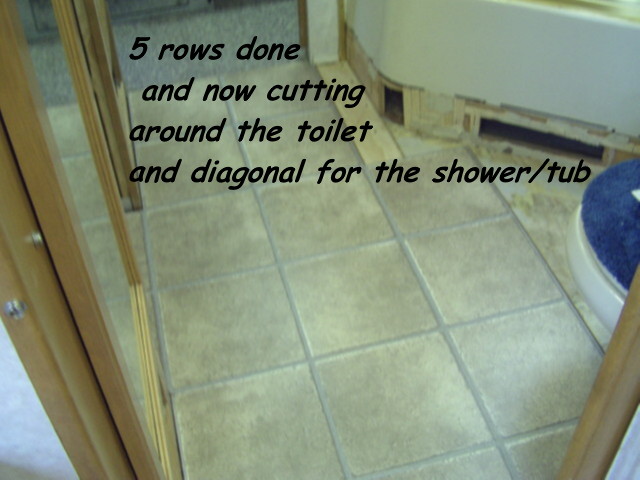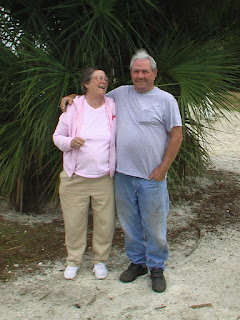Since it's the boring winter months, and we are not travelling yet, I thought I would do some repeats of my most-read blog posts on RV repairs. This one had over 3,000 views when I first posted it. We installed our new bathroom flooring six years ago and it's still working out great!
In October of 2009, we noticed some softening to our bathroom floor, along the edge of the cabinetry on the passenger side.
So we pulled back the vinyl flooring, only to find our subfloor was rotting ! Upon further inspection, we had three sources of water intrusion.
- 1. It turns out that the wheel well area had a leak from the outside and was exposed and it seems it was kicking up water when driving in the rain.
- 2. Our washing machine had never been winterized properly by the previous owners. We found out it had a cracked pump, and replace it, but not before the damage was done with with leakage over a year or so? When winterizing, you have to not only get antifreeze IN the hoses going in, but also IN the pump for the water that goes OUT. Lots of folks miss that step.
- 3. the worst intrusion was along the three horizontal bands of aluminum on the exterior. The top edge of the band allows water in if the clear caulking has worn away. We sealed it up again with ProFlex clear silicone, that is UV resistant. It's a good idea to recheck these three bands of trim around the sides of the Safari motorhomes of our vintage. We now inspect it and fill in any gaps YEARLY !
As we started to tear up the floor, we never realized the damage was this severe.
Our friends Sam and Donna at : http://samdonna-5thwheelvagabonds.blogspot.com just went through the same thing, a major floor repair/replacement job!
This was quite a project!
First we needed to remove all of the vinyl flooring. Over the bad part of the floor, it was easy to pull the vinyl flooring off of, but the rest of the flooring was stuck firm with glue! In the photo above is on the driver’s side of the rig, where it was glued down tight and firm. So it meant we had to be down on the knees and using a putty knife for a few hours to get it all torn out.
We did not have to pull out the toilet, we had to just remove the pedestal housing that surrounds the actual base. That made the job even easier!

(did you know RV washer/dryer combos have CEMENT block weights inside to help with counterbalancing the spinning action? So they are MUCH heavier than household washing machines... ack! )
Now for the messy part:


We found the wood was more and more rotten, the deeper we dug. We wore masks and gloves because of the moldy wood we are grabbing and tearing out, piece by piece. We were finally down to the chassis frame and rigid foam insulation. From the bottom up, outside, we cleaned and sealed the wheel well with spray-on pickup truck bedliner. We also resealed the side trim strip on the wall with a new bead of some ProFlex clear silicone, that is UV resistant for outdoor applications. We will be sure to keep checking it for any future leakage!
After ripping out the rotting wood, we also realized the location in the cabinetry had the washer/dryer combo sitting on just ONE brace of the chassis frame! That very heavy 150 pound machine plus the weight of water when in use was only centered on one piece of frame? That meant the four corner legs were not even on any support other than the flooring and vinyl and foam insulation? hmmmmmm
So we beefed that up too with more bracing on each side before sealing all the bottom up and laying the subfloor and underlayment.


Once we got all the bad wood out, we coated the leading edge of the good wood on the remaining floor with this hardener product, just to be sure no rot would spread any further. The wood was now dry and ready to lay in the two pieces of wood on top of each other. The sub floor and underlayment are also both of treated wood. We coated the two new wood sections with a waterproof sealer on all sides and edges too.
We worked like a team, (just like when we built our house together) and it was a fun project, once we got the rotting wood out! We laid in the two new layers, firmly screwing them down and sealing in between with the layers with construction adhesive. Now the new boards brought it up to the same height as the old floor, so all was level and ready for the new flooring across it all.


Now the fun part starts! Laying on the new flooring!! It’s a laminate product similar to the new hardwood floors, but this in a faux ceramic tile design… almost a match for the previous color of vinyl we had in there, and it matches our carpeting very well too.


It was just measure, cut, click… what fun!
The angles around the shower/tub and sink were a bit complicated, but we used paper templates and transferred the angles onto the panels.. Easy Peasy!


It sure made a huge difference in the stability of the flooring through that whole area. It must have been rotting away under there for years, each time we drove in rain or snow!
PS.... in 2015 we added two bicycle tire inner tubes, one on each side of the washing machine. Once in place, we inflated them to help add stability during the spin cycle. It works WONDERFULLY!
Steve finish-nailed the trim thresholds back into place on both doorways, and added new quarter-round trim behind the toilet and in front of the cabinets. We put the base-surround on the tub again, and the pedestal to the toilet back into place.
It looks as good as new!
And here is ......

We will be attending the funeral for my step dad Lowell on Saturday. It will be a tough "good-bye" for our family. I think some time next week we will be gearing up the motorhome to help Mom get settled back in Florida. So some travelling will be done in future blogs, I promise. Until then, I will post more modifications for you wonderful faithful blog readers!



























































